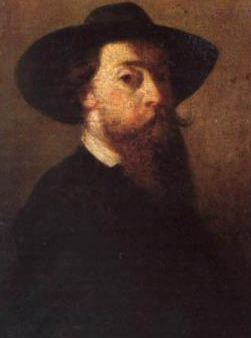Adolphe Joseph Thomas Monticelli was a French painter who is considered a pioneer of Impressionism. His work and notoriety are overshadowed by the great painters that the French art scene produced in the 19th century. Vincent van Gogh and Paul Cézanne found inspiration in Monticelli's works. Monticelli was part of the inner circle of the Parisian artistic community and maintained a friendly relationship with many of his fellow artists. The painter Narcisse Virgile Diaz de la Peña lost a leg after being bitten by a snake, and Monticelli accompanied the artist to paint in the forest of Fontainebleau. The two artists had an intimate relationship. Both were impressed by Ferdinand Victor Eugene Delacroix and took its painting as their model. Together, the artists were looking for a change in painting and broke away from the academic way of painting.
Monticelli's birthplace was Marseille. Here the painter attended the academy and took, his first art lessons. Adolphe moved to Paris and continued to take art courses at École des Beaux-Arts. A much more significant element in the painter's education was museum visits. Adolphe went to the Louvre and copied the works of the great classics on display there. The Frenchman's early works were portraits and oriental scenes. Contrary to academic precepts, Monticelli painted with bold brushstrokes and rebelled against the usual smooth precision. The artist began to play with color. He used colors in various gradations in a single painting. The application of paint was sometimes moderately thick and impasto and in other paintings a thin glaze that allowed the grounding to show through. The painter used it to create romantic scenes and park landscapes flooded with light. He was the companion of lively festivities and the confident performer in many portraits. The later works show a characteristic free application of paint. The last landscape studies that Monticelli painted in his Provençal homeland seem almost experimental. The paint seems to be applied with a spatula and is often thickly applied with a palette on wooden panels. Art critics thought Monticelli was crazy, which the artist noted with humor and continued to follow his impulses.
The question of why Monticelli is not mentioned in the same breath as the great Impressionists probably has several causes. For one, it was important for an artist's success to be shown in the exhibitions of the Paris Academies. Monticelli never exhibited at the Salon and was free to sell his works. The artist repeatedly left the city and spent periods of his life in his homeland. Thus he left Paris during the revolution of 1848 and when the Franco-Prussian War broke out. Although he served the social taste of the time with his subjects, the painter also repeatedly sought contact with the artistic avant-garde. Vincent van Gogh had the great desire to meet the artist Adolphe Monticelli personally, but unfortunately he died a few months before van Gogh reached Paris.
×





.jpg)
.jpg)
.jpg)
.jpg)
_-_(MeisterDrucke-905713).jpg)
_-_(MeisterDrucke-905713).jpg)
_-_(MeisterDrucke-1656050).jpg)
_-_(MeisterDrucke-1656050).jpg)
.jpg)
.jpg)
_Dim_365x48_cm_Musee_Gr_-_(MeisterDrucke-1418956).jpg)
_Dim_365x48_cm_Musee_Gr_-_(MeisterDrucke-1418956).jpg)
.jpg)
.jpg)
.jpg)
.jpg)
_Huile_sur_to_-_(MeisterDrucke-1321060).jpg)
_Huile_sur_to_-_(MeisterDrucke-1321060).jpg)
.jpg)
.jpg)
_-_(MeisterDrucke-1473464).jpg)
_-_(MeisterDrucke-1473464).jpg)
.jpg)
.jpg)
.jpg)
.jpg)
.jpg)
.jpg)
.jpg)
.jpg)
_-_(MeisterDrucke-969939).jpg)
_-_(MeisterDrucke-969939).jpg)
.jpg)
.jpg)
.jpg)
.jpg)
.jpg)
.jpg)
.jpg)
.jpg)
_Peinture_de_Adolphe_Thomas_-_(MeisterDrucke-1322806).jpg)
_Peinture_de_Adolphe_Thomas_-_(MeisterDrucke-1322806).jpg)
.jpg)
.jpg)
_-_(MeisterDrucke-1034616).jpg)
_-_(MeisterDrucke-1034616).jpg)
.jpg)
.jpg)
.jpg)
.jpg)
.jpg)
.jpg)
.jpg)
.jpg)
.jpg)
.jpg)
_19th_century_S_-_(MeisterDrucke-960337).jpg)
_19th_century_S_-_(MeisterDrucke-960337).jpg)
.jpg)
.jpg)
_Peinture_dAdolphe-Thomas-Joseph_(Adolphe_Thomas_-_(MeisterDrucke-1313653).jpg)
_Peinture_dAdolphe-Thomas-Joseph_(Adolphe_Thomas_-_(MeisterDrucke-1313653).jpg)
.jpg)
.jpg)
.jpg)
.jpg)
.jpg)
.jpg)
.jpg)
.jpg)
.jpg)
.jpg)
 - (MeisterDrucke-156059).jpg)
 - (MeisterDrucke-156059).jpg)
_-_(MeisterDrucke-1495882).jpg)
_-_(MeisterDrucke-1495882).jpg)
.jpg)
.jpg)
.jpg)
.jpg)
.jpg)
.jpg)
.jpg)
.jpg)
.jpg)
.jpg)
.jpg)
.jpg)
_-_(MeisterDrucke-1504907).jpg)
_-_(MeisterDrucke-1504907).jpg)
.jpg)
.jpg)
.jpg)
.jpg)
.jpg)
.jpg)
_-_(MeisterDrucke-1173071).jpg)
_-_(MeisterDrucke-1173071).jpg)
_-_(MeisterDrucke-1515561).jpg)
_-_(MeisterDrucke-1515561).jpg)
.jpg)
.jpg)
.jpg)
.jpg)
_-_(MeisterDrucke-1495442).jpg)
_-_(MeisterDrucke-1495442).jpg)
.jpg)
.jpg)
.jpg)
.jpg)
_-_(MeisterDrucke-1114311).jpg)
_-_(MeisterDrucke-1114311).jpg)
_-_(MeisterDrucke-559056).jpg)
_-_(MeisterDrucke-559056).jpg)
.jpg)
.jpg)
.jpg)
.jpg)
.jpg)
.jpg)
_-_(MeisterDrucke-1122615).jpg)
_-_(MeisterDrucke-1122615).jpg)
_-_(MeisterDrucke-1316884).jpg)
_-_(MeisterDrucke-1316884).jpg)
.jpg)
.jpg)
.jpg)
.jpg)
.jpg)
.jpg)
.jpg)
.jpg)
.jpg)
.jpg)
.jpg)
.jpg)
.jpg)
.jpg)
.jpg)
.jpg)
.jpg)
.jpg)
.jpg)
.jpg)
.jpg)
.jpg)
.jpg)
.jpg)
.jpg)
.jpg)
.jpg)
.jpg)
.jpg)
.jpg)
_-_(MeisterDrucke-905711).jpg)
_-_(MeisterDrucke-905711).jpg)
.jpg)
.jpg)
.jpg)
.jpg)
.jpg)
.jpg)
.jpg)
.jpg)
.jpg)
.jpg)
_-_(MeisterDrucke-1119138).jpg)
_-_(MeisterDrucke-1119138).jpg)
.jpg)
.jpg)
_-_(MeisterDrucke-1016754).jpg)
_-_(MeisterDrucke-1016754).jpg)
_-_(MeisterDrucke-1472864).jpg)
_-_(MeisterDrucke-1472864).jpg)
.jpg)
.jpg)
.jpg)
.jpg)
.jpg)
.jpg)
_-_(MeisterDrucke-1113320).jpg)
_-_(MeisterDrucke-1113320).jpg)
_-_(MeisterDrucke-1103268).jpg)
_-_(MeisterDrucke-1103268).jpg)
.jpg)
.jpg)
.jpg)
.jpg)
.jpg)
.jpg)
.jpg)
.jpg)
_-_(MeisterDrucke-1518228).jpg)
_-_(MeisterDrucke-1518228).jpg)
.jpg)
.jpg)
.jpg)
.jpg)
.jpg)
.jpg)






